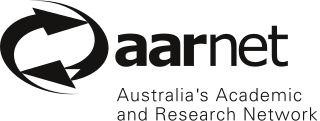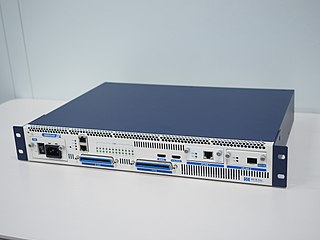
Telecommunications in Australia refers to communication in Australia through electronic means, using devices such as telephone, television, radio or computer, and services such as the telephony and broadband networks. Telecommunications have always been important in Australia given the "tyranny of distance" with a dispersed population. Governments have driven telecommunication development and have a key role in its regulation.
Singtel Optus Pty Limited is an Australian telecommunications company headquartered in Macquarie Park, a suburb in the Northern Sydney region of Sydney, New South Wales, Australia. It is a wholly owned subsidiary of Singaporean telecommunications company Singtel.

AARNet provides Internet services to the Australian education and research communities and their research partners.
The Eastern Africa Submarine Cable System (EASSy) is an undersea fibre optic cable system connecting countries in Eastern Africa to the rest of the world.
SEA-ME-WE3 or South-East Asia - Middle East - Western Europe 3 is an optical submarine telecommunications cable linking those regions and is the longest in the world. Completed in late 2000, it is led by France Telecom and China Telecom, and is administered by Singtel, a telecommunications operator owned by the Government of Singapore. The Consortium is formed by 92 other investors from the telecom industry. It was commissioned in March 2000.

Alcatel–Lucent S.A. was a multinational telecommunications equipment company, headquartered in Boulogne-Billancourt, France. It was formed in 2006 by the merger of France-based Alcatel and U.S.-based Lucent, the latter being a successor of AT&T's Western Electric and a holding company of Bell Labs.
JASURAUS was a 5.332 Gbit/s, 2,800 km optical submarine telecommunications cable that connected Port Hedland, Australia, to Jakarta, Indonesia, with a further interconnection to the APCN and which was decommissioned in 2012.
The Telstra Endeavour is a submarine cable connecting Sydney and Hawaii. The cable went live in October 2008, with a capacity of 1.28 terabits per second in the future It was proposed on 28 March 2007 by Telstra, the largest telecommunications carrier in Australia.

Vocus Group Limited, formerly known as Vocus Communications, is an international telecommunications company headquartered in North Sydney, Australia. Founded by James Spenceley as a wholesale, business, government and consumer telecommunications provider, Vocus owns and manages Australia's second largest intercapital fibre network. Vocus provides retail, wholesale and corporate telecommunications services across Australia and New Zealand. Vocus offers data network services such as Internet, dark fibre, IP WAN, unified communications and telephony and cloud services to mid, large and corporate businesses direct and also acts as a wholesaler. The company owns and operates 18 data centres across Australia and New Zealand and has an onshore network operations centre run by the engineers who built the network.
CIMIC Group Limited is an engineering-led construction, mining, services and public private partnerships leader working across the lifecycle of assets, infrastructure and resources projects.

SEACOM launched Africa's first broadband submarine cable system along the continent's Southern coasts in 2009. SEACOM is privately owned and operated.
PIPE Pacific Cable (PPC-1) is a 6,900 km submarine cable laid by PIPE Networks. It runs from Cromer, New South Wales, in Australia, to Piti, Guam.
The Institute for a Broadband-Enabled Society (IBES) is an Australian research institute focusing on the development of broadband-enabled applications and technologies. The institute is based in the Department of Electrical and Electronic Engineering at The University of Melbourne in Victoria (Australia). Research in the centre is clustered around five research themes:
Chorus is a provider of telecommunications infrastructure throughout New Zealand. It is listed on the NZX stock exchange and is in the NZX 50 Index. The company owns the majority of telephone lines and exchange equipment in New Zealand; and was responsible for building approximately 70% of the country's fibre-optic UFB network, receiving a government subsidy of $929 million to do so.

G.fast is a digital subscriber line (DSL) protocol standard for local loops shorter than 500 meters, with performance targets between 100 Mbit/s and 1 Gbit/s, depending on loop length. High speeds are only achieved over very short loops. Although G.fast was initially designed for loops shorter than 250 meters, Sckipio in early 2015 demonstrated G.fast delivering speeds over 100 Mbit/s at nearly 500 meters and the EU announced a research project.
West Indian Ocean Cable Company (WIOCC) operates as a wholesaler, providing capacity to international telecoms, cloud operators, content providers and internet service providers within and out of Africa. WIOCC offers carriers connectivity to over 550 locations across 30 African countries – utilising more than 75,000 km (47,000 mi) of terrestrial fibre and 200,000 km (120,000 mi) of submarine fibre-optic cable. WIOCC's international network reach currently extends to 100 cities in 29 countries in Europe and more than 700 cities in 70 countries globally.

MAREA is a 6,605 km long transatlantic communications cable connecting the United States with Spain. Owned and funded by Microsoft and Meta Platforms, but constructed and operated by Telxius, a subsidiary of the Spanish telecom company Telefónica, it is the "highest-capacity submarine cable in the world" with a system design capacity of 200 terabits per second as of 2019.

Ventia is an essential infrastructure services provider based in Australia and New Zealand that provides a range of essential services to clients in both the public and private sectors. Ventia was founded in 2015 and is headquartered in North Sydney, Australia. Ventia has secondary corporate offices located in Auckland, Brisbane, Melbourne, Adelaide and Perth.
The Australia Singapore Cable (ASC) is a 4,600 km fibre-optic submarine communications cable that entered service in September 2018, linking Australia and Singapore via Christmas Island and Indonesia. ASC is owned and operated by Vocus Communications and interconnects with the Vocus Australian domestic optical fibre network at the Australian landing site in Perth. The ASC consists of four fibre pairs and, at launch, had a total design capacity of 40 terabits per second.
The Oman Australia Cable (OAC) is a 9,800 km fibre-optic submarine communications cable that entered service in September 2022, linking Oman and Australia via the Cocos (Keeling) Islands. The cable consists of three fibre pairs and had an initial design capacity of 39 terabits per second.








